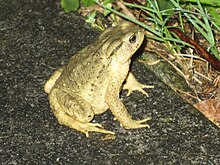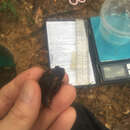Description
provided by AmphibiaWeb articles
Bufo bankorensis is the largest species of frog found on Taiwan, with adult males ranging from 60-110 mm and females from 36.5-104 mm in snout-vent length. Head length is about the same as head width. Tympana are small, about 1/3 the size of the eyes, and partly covered by skin. Parotoid glands are present and shaped like kidney beans. The dorsal surfaces and limbs are warty. Hind limbs are very short. Webbing is present on four of five toes (Fei 1999). Dorsal coloration varies and may be reddish, yellowish, greenish or dark brown. Patterning also varies, with some individuals having a dorsolateral black stripes, running beneath each parotoid gland. Black or orange-reddish dots may or may not be present. These frogs are reportedly also capable of metachrosis, or changing color (ymsnp.gov.tw).Tadpoles are about 36 mm in total length, with the heads about 13.3 mm. Bodies and tails are blackish brown, with a gray tail tip (Fei 1999).
- Fei, L. (1999). Atlas of Amphibians of China. Henan Publishing House of Science and Technology, Zhengzhou.
- Huang, C., Wang, C-P., and Ping-Chun, L-H. (2007). ''Toads (Bufo bankorensis) influence litter chemistry but not litter invertebrates and litter decomposition rates in a subtropical forest of Taiwan.'' Journal of Tropical Ecology, 23, 161-168.
- Huang, W., and Yuh-Lin, J. (2005). ''Reproductive characteristics of Bufo bankorensis at two elevations in Taiwan.'' Zoological Science, 22, 111-117.
- IUCN, Conservation International, and NatureServe. (2006). Global Amphibian Assessment: Bufo bankorensis. www.globalamphibians.org. Accessed on 3 March 2008.
- “Bufo bankorensis.”
http://e-info.org.tw/topic/frog/Bufo-bankorensis/Bufo-bankorensis.htm Accessed on 3 March 2008.
- “Bufo bankorensis.” http://www.ymsnp.gov.tw/web/webpage.aspx?f=data_file/animal93/animal93_d3-421.htm Accessed on 7 March 2008.
Distribution and Habitat
provided by AmphibiaWeb articles
Bufo bankorensis is endemic to Taiwan, and widely distributed over the island (Fei 1999). It is generally found in mountainous or hilly areas but occurs at elevations ranging from sea level to 2,700 meters (IUCN 2006). Habitat includes broadleaf forest, mixed forests, orchards, and cultivated fields (IUCN 2006); this species has also been reported to occur at the edges of farms, gardens, creeks, and roads, in dirt holes, and under rocks (Fei 1999).
Life History, Abundance, Activity, and Special Behaviors
provided by AmphibiaWeb articles
Bufo bankorensis is nocturnal (Fei 1999). Breeding season differs depending on the altitude (and temperature) at which a population resides (Huang et al. 2005). Two populations have been described: the high-elevation, temperate population breeds throughout the year, while the lower-elevation, subtropical population has a more limited breeding season, extending from September to February (Huang et al. 2005). They breed in streams and more permanent pools (IUCN 2006). Eggs are black and pearl-like and are laid in long strands (ymsnp.gov.tw). Tadpoles hatch in about five days, are dark black in color and gather together to form large groups (ymsnp.gov.tw). Tadpoles feed on humus and algae (ymsnp.gov.tw). Adult B. bankorensis consume mainly ants (53%), with coleopterans (16%) and termites (9 %) also providing significant portions of the diet (Hou, unpublished data, cited in Huang et al. 2007).
Life History, Abundance, Activity, and Special Behaviors
provided by AmphibiaWeb articles
Bufo bankorensis are very common in Taiwan and are classified as Least Concern on the IUCN Red List (IUCN 2006).
Relation to Humans
provided by AmphibiaWeb articles
The skin and skin secretions of Bufo bankorensis are sometimes used for traditional medicinal purposes in Taiwan. The white fluid extracts from the parotoid glands are made into a dry paste and then eaten. The paste is believed to have antidote-like and diuretic purposes (e-info.org.tw).
Bufo bankorensis
provided by wikipedia EN
Bufo bankorensis (vernacular names: Central Formosa toad, Bankor toad) is a species of toad in the family Bufonidae.[2] It is endemic to Taiwan[2][3][4] and widely distributed at elevations up to 3,000 m (9,800 ft) above sea level.[3][4] There has been doubts about its separatedness from Bufo gargarizans from China and even other species,[2] but it is currently considered a valid species.[2][3][4]
Description
Bufo bankorensis is a large toad that can reach 15 cm (5.9 in),[3] even 20 cm (7.9 in) in snout–vent length.[4] Females are larger than males.[4] The snout is short. Dorsolateral ridge is absent. The tympanum is not prominent. The parotoid glands are kidney-shaped. Skin is rough and covered with pointed tubercles of various size. Coloration is light brown color with orange, yellow, or black markings.[3]
Habitat and conservation
Bufo bankorensis are found in a range of habitats at elevations up to 3,000 m (9,800 ft):[3][4] broadleaf forests, cultivated fields, mixed forests, and orchards.[1] They can be seen foraging on insects under street lights during rainy nights.[3][4] Breeding can take place in both streams and pools.[1][3][4] One study found that a temperate population could breed throughout the year, while a subtropical population only bred during the cooler part of year, from September to March.[5]
While Bufo bankorensis is a very common species, habitat loss remains a threat to it. It is also collected for food and traditional medicine.[1]
References

- license
- cc-by-sa-3.0
- copyright
- Wikipedia authors and editors
Bufo bankorensis: Brief Summary
provided by wikipedia EN

Bufo bankorensis (vernacular names: Central Formosa toad, Bankor toad) is a species of toad in the family Bufonidae. It is endemic to Taiwan and widely distributed at elevations up to 3,000 m (9,800 ft) above sea level. There has been doubts about its separatedness from Bufo gargarizans from China and even other species, but it is currently considered a valid species.
- license
- cc-by-sa-3.0
- copyright
- Wikipedia authors and editors


